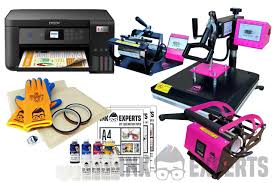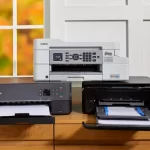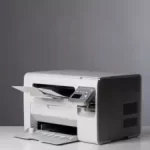Sublimation printing is one of the most innovative and popular printing technologies available today. It involves transferring dye into a material or fabric using heat and pressure, creating vibrant, high-quality, and durable prints. But what exactly is a sublimation printer, and why is it making waves in the printing industry?
A sublimation printer is a device specifically designed to perform sublimation printing by turning solid sublimation dyes into a gaseous state without passing through the liquid phase. This process allows the ink to penetrate the surface of the material, ensuring a long-lasting bond between the ink and the substrate.
One of the most distinguishing features of sublimation printers is their ability to print on polyester fabrics and other coated surfaces. They are particularly valued in industries like fashion, advertising, and personalized gift-making, where vibrant and durable designs are essential. Whether you’re creating custom mugs, t-shirts, or phone cases, sublimation printers provide an efficient and professional solution.
How Does Sublimation Printing Work?
At the heart of sublimation printing is the process of sublimation—a chemical reaction where solid ink turns into a gas when exposed to heat. This gas embeds itself into the surface of the material, producing a vibrant and permanent image.
The process starts with a special sublimation printer that uses sublimation-specific inks. The image is first printed onto a sublimation paper, which acts as a carrier for the design. Next, the sublimation paper and the substrate (such as a t-shirt, mug, or phone case) are placed into a heat press. The heat press applies both high heat (usually around 350-400°F) and pressure, causing the ink to transform into a gas and bond with the material.
This process works best on polyester or polymer-coated surfaces because the gas can penetrate these materials’ fibers. The result? A vibrant, scratch-resistant, and fade-resistant design that feels like part of the fabric or surface rather than something sitting on top.
Key Features of Sublimation Printers
Sublimation printers are packed with features that set them apart from other types of printers. Here’s what makes them stand out:
- Compatibility with Various Materials
Sublimation printers can print on a range of materials, from fabrics to ceramics, metals, and plastics, provided they have a polyester coating or polymer content. This versatility makes them a go-to choice for businesses. - High-Quality Image Reproduction
If you’re after crisp, vibrant, and detailed images, sublimation printers are unmatched. They deliver photo-quality prints that retain their sharpness and color vibrancy for years. - Speed and Efficiency
Sublimation printers are designed for quick turnaround times, making them ideal for high-volume production. Once the workflow is set, you can produce hundreds of identical prints with consistent quality.
Types of Sublimation Printers
Sublimation printers come in various sizes and capacities, tailored to different needs.
- Desktop Sublimation Printers
These are compact and designed for small-scale printing tasks. They’re perfect for hobbyists or small businesses creating personalized items like mugs, keychains, or t-shirts. - Large-Format Sublimation Printers
Built for industrial use, these printers handle large rolls of fabric or materials, making them ideal for producing banners, apparel, and upholstery. - Consumer vs. Professional-Grade Printers
While consumer-grade sublimation printers are more affordable and suitable for beginners, professional-grade options come with enhanced features like faster speeds, higher resolutions, and compatibility with larger materials.
Benefits of Using a Sublimation Printer
Sublimation printing offers several advantages that make it a preferred choice in many industries:
- Durable and Long-Lasting Prints
Unlike traditional printing methods, sublimation designs don’t crack, peel, or fade over time. This makes them ideal for products that endure regular wear and tear. - Wide Range of Applications
From custom t-shirts to home decor, sublimation printers can handle various creative projects. The versatility is unmatched, allowing you to expand your product range easily. - Environmentally Friendly Solution
Sublimation printing uses water-based inks and eliminates the need for harsh chemicals. This makes it a more sustainable choice for eco-conscious businesses.
Sublimation printing is versatile, making it suitable for a variety of creative and business applications. Let’s dive into some of the most popular uses:
Customized Apparel and Textiles
One of the most common uses of sublimation printing is creating personalized clothing. Whether it’s custom t-shirts, jerseys, or leggings, sublimation ensures the designs are vibrant, detailed, and durable. Sublimation printing is particularly favored for polyester-based apparel, as the process bonds directly with the fibers, making the designs resistant to fading or cracking.
Promotional Products and Branding
Businesses rely on sublimation printing to produce promotional items such as branded mugs, coasters, mouse pads, and tote bags. These items are perfect for giveaways, corporate events, and product launches. Sublimation’s ability to create high-quality prints ensures that branding looks professional and leaves a lasting impression.
Home Decor and Photography
Sublimation printing allows you to transfer stunning designs and photos onto home decor items like cushions, curtains, photo frames, and wall art. For photographers, sublimation printing provides an excellent way to showcase their work on metal, canvas, or ceramic tiles, giving a unique and professional look to their art.
Advantages Over Traditional Printing Methods
Sublimation printing offers several key advantages compared to traditional printing methods, making it a game-changer in the industry.
- Vibrant and Permanent Colors
Sublimation embeds the ink directly into the material, creating colors that are rich and vibrant. Unlike screen printing or vinyl, the colors remain bright and intact even after years of use and multiple washes. - No Peeling or Cracking
Unlike other printing methods where designs are applied to the surface, sublimation fuses the ink into the substrate. This means there’s no risk of the design peeling, cracking, or flaking over time. - Cost-Effectiveness for Bulk Orders
For businesses producing large quantities, sublimation printing can be cost-effective. Once the setup is complete, printing hundreds of items is quick and efficient, making it a great option for bulk orders.
Factors to Consider Before Buying a Sublimation Printer
If you’re considering investing in a sublimation printer, it’s essential to evaluate your needs and budget. Here are some key factors to keep in mind:
Initial Investment and Running Costs
While sublimation printers are generally more expensive than traditional printers, their long-term benefits often outweigh the initial costs. Keep in mind additional expenses such as sublimation inks, heat presses, and compatible substrates.
Required Materials and Compatibility
Sublimation printing works best on polyester fabrics or polymer-coated materials. Before purchasing a printer, ensure it is compatible with the substrates you plan to use, whether it’s clothing, mugs, or decor items.
Space and Maintenance Requirements
Some sublimation printers, especially large-format ones, require significant space. Additionally, regular maintenance is crucial to ensure optimal performance, such as cleaning the nozzles and checking for ink clogs.
Choosing the Right Sublimation Printer for Your Needs
With so many sublimation printers available, choosing the right one can be challenging. Here are some tips to help you decide:
- Understand Your Printing Needs
Are you a hobbyist looking to print on small items like mugs or a professional needing large-scale production? Determine your specific needs to select the right type of printer. - Top Brands to Consider
Leading brands like Epson, Sawgrass, and Ricoh offer high-quality sublimation printers. Each brand has its strengths, so research their product lines to find one that fits your requirements. - Compare Features and Prices
Evaluate features like print speed, resolution, and material compatibility. Compare prices across different models to ensure you’re getting the best value for your investment.
Setting Up a Sublimation Printing Workflow
Creating an efficient sublimation printing workflow is essential for consistent and high-quality output. Here’s what you’ll need:
Essential Equipment and Tools
- A sublimation printer
- Sublimation inks
- Sublimation paper
- A heat press machine
- Compatible blank substrates (like mugs, t-shirts, or coasters)
Tips for Optimizing Efficiency
- Organize your workspace to minimize downtime between tasks.
- Use templates and design software to streamline the printing process.
- Conduct test prints to ensure color accuracy before starting large batches.
Common Mistakes to Avoid
- Using non-compatible materials (e.g., cotton fabrics or uncoated ceramics).
- Skipping maintenance checks, which can lead to clogs and print quality issues.
- Applying the wrong heat and pressure settings, resulting in faded or uneven designs.

Sublimation Printing for Business
Thinking of turning sublimation printing into a business? Here’s how you can get started:
How to Start a Sublimation Printing Business
- Invest in essential equipment and materials.
- Identify your niche (e.g., custom apparel, corporate gifts, or home decor).
- Build a portfolio showcasing your designs and printing capabilities.
Popular Niches for Sublimation Entrepreneurs
- Customized Gifts: Items like personalized mugs, phone cases, and photo frames.
- Sportswear: Sublimated jerseys and activewear with unique designs.
- Event Merchandise: Custom t-shirts and accessories for weddings, birthdays, and corporate events.
Marketing Strategies to Grow Your Business
- Leverage social media platforms like Instagram and Pinterest to showcase your designs.
- Partner with local businesses to offer branded products.
- Set up an online store to reach a wider audience and offer easy ordering.
Costs Involved in Sublimation Printing
Before starting, it’s essential to understand the costs involved. Here’s a breakdown:
- Printer and Ink Expenses
Sublimation printers range from $300 for entry-level models to over $10,000 for professional-grade options. Sublimation inks can also be pricey but are essential for high-quality prints. - Blank Materials and Substrates
Depending on your business niche, blank materials like t-shirts, mugs, or photo panels can range from a few dollars to higher-priced specialty items. - Operational and Maintenance Costs
Regular maintenance and cleaning supplies are necessary to keep your printer running efficiently. Factor in costs for electricity, heat presses, and replacement parts.
Common Challenges and How to Overcome Them
Even with its many advantages, sublimation printing comes with challenges. Here’s how to tackle them:
- Issues with Color Accuracy
Use ICC profiles to ensure your printer and monitor produce consistent colors. Conduct test prints to make adjustments as needed. - Printer Maintenance and Troubleshooting
Regularly clean the printhead and check for ink clogs. Follow the manufacturer’s maintenance guidelines to prevent downtime. - Avoiding Sublimation Printing Errors
Ensure your materials are compatible and that you’re using the correct heat press settings. Always double-check your design alignment before pressing.
Tips for Getting the Best Results with Sublimation Printing
Want to achieve flawless results? Follow these tips:
- Proper Heat Press Settings
Use the recommended time, temperature, and pressure settings for your substrate. Too much or too little heat can ruin your design. - Best Practices for Handling Substrates
Keep substrates clean and free from dust or fingerprints before pressing. Store them in a dry and controlled environment to maintain quality. - Quality Control Tips
Inspect every print for color consistency, alignment, and clarity. Make necessary adjustments to maintain a professional standard.
Future of Sublimation Printing Technology
The future of sublimation printing is bright, with continuous advancements making the technology even more accessible and versatile.
Innovations in Sublimation Printing
- Faster and more efficient printers.
- Eco-friendly inks and substrates.
- Enhanced color reproduction technologies.
Growing Demand for Personalization
The rise in demand for personalized items ensures that sublimation printing will remain a sought-after solution for years to come.
Environmental Advancements
Sustainability is becoming a priority, leading to the development of biodegradable substrates and water-based sublimation inks.
Conclusion
Sublimation printing is a versatile, high-quality, and durable printing method that caters to a wide range of creative and business applications. Whether you’re a hobbyist or a professional, sublimation printing offers endless possibilities for customization and innovation. With its vibrant colors, long-lasting results, and eco-friendly benefits, investing in a sublimation printer is a smart choice for anyone looking to step into the world of custom printing.
FAQs
- What materials can I use for sublimation printing?
Sublimation works best on polyester fabrics and polymer-coated materials like mugs, metals, and plastics. - Is sublimation printing expensive to maintain?
While the initial costs are high, the running and maintenance costs are manageable with proper care and bulk production. - Can I use a regular printer for sublimation?
No, you need a printer designed specifically for sublimation or converted to handle sublimation inks. - What is the lifespan of sublimation-printed products?
Sublimation prints are highly durable and can last for years without fading, peeling, or cracking. - How do I choose the best sublimation printer for my business?
Evaluate your production needs, budget, and the type of items you plan to print. Look for reputable brands and reliable features.



